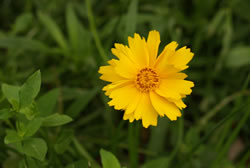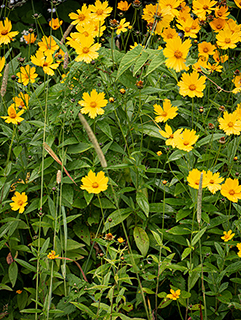Tickseed or Coreopsis, as it is more formally known, brings charm and cheer to any garden.
They bloom in full sun from May to Aug., depending on the species. Typically yellow, the flowers are daisy-like.
Tickseed belongs in the Sunflower family. There are 75 to 80 species native to North and South America. The four species commonly grown here are large-flowered tickseed; C. grandiflora; lance-leafed tickseed, C. lanceolata; thread-leaf coreopsis, C. verticillate; and pink coreopsis, C. rosea. Pink coreopsis grows best in sandy soils.
A low-maintenance flower, it likes dry to medium, well drained soil.

Here is a quick profile of one coreopsis, large-flowered tickseed. It grows between 1.5 and 2.5 ft tall and spreads from 1 to 1.5 ft. This species blooms from June to Aug. Blossoms are yellow rays with darker yellow centers. An open-pollinated plant, it grows from seed, division and rhizomes. It will self-seed, but is well behaved. Deadheading will encourage new blooms.

Tickseed has been labeled a keystone perennial, one of a few plants that supports numerous insects. Seven caterpillar species use it as a host plant and 22 pollen specialist bee species rely on it. It attracts butterflies as well. Rabbit and deer resistant, it supports pollinating by being such a long-blooming plant
Coreopsis can be used as a border, in naturalized areas, meadows, prairies, or cottage gardens. For more information, see the Missouri Botanical Society.
##
